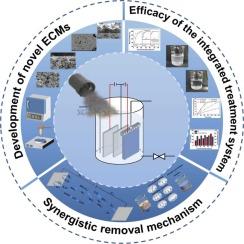Electrochemical membranes for rare earth mine water treatment: sequential removal of rare earth ions and ammonia nitrogen
IF 12.2
1区 环境科学与生态学
Q1 ENGINEERING, ENVIRONMENTAL
引用次数: 0
Abstract
The compound pollution caused by rare earth elements (REEs) and high concentrations of ammonia and nitrogen in the drainage water of rare earth mines poses a serious threat to water ecological safety, necessitating urgent resolution. To address this challenge, (Sb, F)-doped SnO2-modified ceramic membranes (AFTO-CM) were developed for use in an integrated electro-flocculation-electro-oxidation-membrane separation treatment system. Physicochemical characterization revealed that AFTO-CM possesses excellent electrical conductivity (2.84 Ω/sq), electrocatalytic properties (charge transfer resistance of 1.41 Ω), operational stability (sustained performance at 30 mA for over 45 h), hydrophilicity (contact angle of 0°), and a porous structure. In the integrated treatment system, optimization of key factors achieved removal of REEs and ammonia nitrogen (99.84-99.98%). In addition, physicochemical characterization analyses confirmed the removal of REEs and Al3+ hydrolysis products through the formation of hydroxyl complexes. Product analysis further indicated that ammonia nitrogen removal primarily occurred through oxidation by free chlorine. Theoretical calculations showcased that Sb and F doping reduced the energy barrier of Cl2 desorption in the SnO2-based conducting layer while increasing the barrier for oxygen evolution reaction (OER) intermediates (*OOH), thus enhancing chlorine evolution reaction (CER) activity. Hence, this study provides valuable insights into the efficient purification of rare earth mine drainage.

求助全文
约1分钟内获得全文
求助全文
来源期刊

Journal of Hazardous Materials
工程技术-工程:环境
CiteScore
25.40
自引率
5.90%
发文量
3059
审稿时长
58 days
期刊介绍:
The Journal of Hazardous Materials serves as a global platform for promoting cutting-edge research in the field of Environmental Science and Engineering. Our publication features a wide range of articles, including full-length research papers, review articles, and perspectives, with the aim of enhancing our understanding of the dangers and risks associated with various materials concerning public health and the environment. It is important to note that the term "environmental contaminants" refers specifically to substances that pose hazardous effects through contamination, while excluding those that do not have such impacts on the environment or human health. Moreover, we emphasize the distinction between wastes and hazardous materials in order to provide further clarity on the scope of the journal. We have a keen interest in exploring specific compounds and microbial agents that have adverse effects on the environment.
 求助内容:
求助内容: 应助结果提醒方式:
应助结果提醒方式:


